|
When it comes down to it there is nothing better than manual tools for your Lock pick Set, whether they be retail, homebrew, macgyver style. DIY'ers look here.
 by Anavaree » 15 May 2012 16:06 by Anavaree » 15 May 2012 16:06
I am posting this more for curiosity’s sake as than use. I am sure many of us have sanded down picks to make finer profiled ones for use in narrow keyways. I decided to go about this process in a different way. I happen to have access to some very powerful acids at work and I wondered if these acids could be used to reduce the overall dimensions of a pick while leaving the pick relatively undamaged. This was to be my first victim. 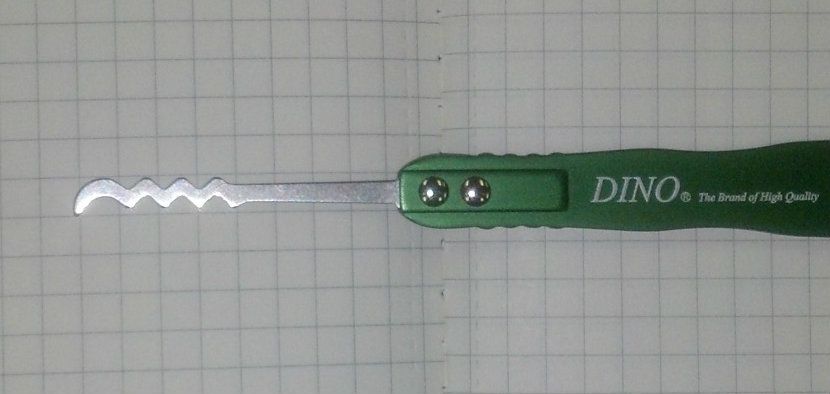 My wife got me the Klingon Torture tools for Christmas or my birthday or something one year and I thought I would never end up using this specific profile anyway, in case it was damaged and ruined. The metal is stainless steel, seemingly of pretty good quality. I started with hydrochloric acid, 35%, which is almost full strength. I was hoping that the pick would show an energetic reaction to the acid, but I was disappointed. It showed no reaction. Our lab tech had nitric acid lying around, also a very high concentration of 65%, which also showed very little reaction to the steel. My lab tech, Steve, had heard about mixing nitric and HCL acids together to make nitro-muriatic acid. This is supposed to be a very, very nasty acid. I dropped the pick and after a few seconds I received a reaction.  This picture is after about 30 seconds in the acid. Unfortunately I was planning on leaving the pick in for 5 minutes and then measure the change. However, I got distracted and left it in for almost an hour. There wasn’t much left when I got back. The acid had turned nearly black and the pick had dissolved to paper thin. The last little fragment holding it together broke when I took it out of the acid. 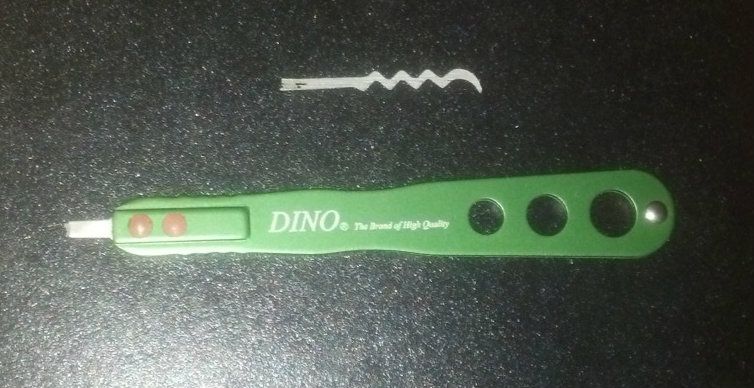 It’s hard to tell but the pick is nearly see through it’s so thin. But, now I knew that the acid worked and I also knew what NOT to do, which is almost as important in science. I continued the project but for now I have to go. I will hopefully continue the post tonight.
-
Anavaree
-
- Posts: 152
- Joined: 26 Jul 2011 8:53
- Location: Kentucky, USA
 by cledry » 15 May 2012 17:05 by cledry » 15 May 2012 17:05
Sounds interesting, I look forward to your future experiments. Nice clear photos too.
I suppose a disclaimer should be posted about the danger of using acids for people less experienced than yourself. I'm not a moderator but I would hate for anyone to injure themselves replicating your experiments.
Jim
-

cledry
-
- Posts: 2836
- Joined: 7 Mar 2009 23:29
- Location: Orlando
-
 by Anavaree » 15 May 2012 17:12 by Anavaree » 15 May 2012 17:12
Very true, acids should be used with extreme caution, expecially these acids.
The good thing is, the acids i am using are considered hazardous materials and are controlled by the gov and would be very hard to get a hold of without the proper training.
But still, EXTREME CAUTION should be used with any acid or caustic as exposure could cause all of the usual disfiguring injuries.
Ok, so now back to cooking dinner. Will try to post more tonight.
~Jesse
-
Anavaree
-
- Posts: 152
- Joined: 26 Jul 2011 8:53
- Location: Kentucky, USA
 by Anavaree » 15 May 2012 18:47 by Anavaree » 15 May 2012 18:47
I return, hunger satiated, and will now continue in the name of SCIENCE! Now that I had a game plan, I started with a new pick. I grabbed a Southord broken key extractor. Since many of you out there may not have the Dino picks, I figured I should use something we all might have. If this project ends up feasible, I would be able to apply the process to any pick and I don’t have any use for this extractor. This is the before.  My final goal was to see how much I could remove without damaging the pick. I will explain why I stopped when I did, later. These are the numbers from the first 4 dips. 5 min, 5 min, 10 min and 10 more minutes for a total of 30 minutes in acid. 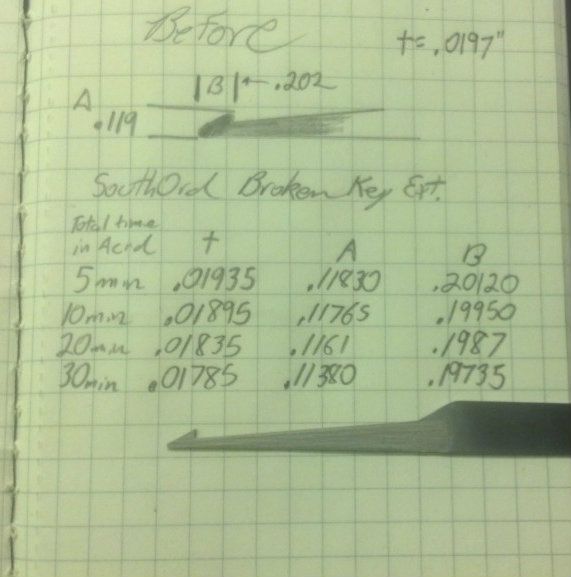 Couple of pics follow. I will explain below the pics. 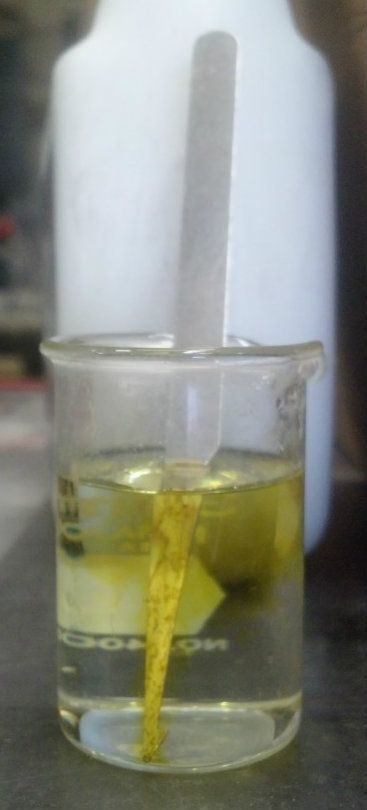 Pick during the first 5 min dip. Slight discoloration of the acid and metal. By now you should have all noticed that I put the wrong picture in the first post. That is obviously not the Dino pick in the acid up there.  This is hard to see, but after 5 minutes the polish on the workin’ side of the pick was gone.  This is the pick after 30 minutes in acid. Obvious erosion has occurred. The next step was an acid change and more dipping. Back for more, later. My typing ability is about as good as my ability to walk through walls. You know, I can do it, but it hurts. (Disclaimer, OP cannot actually walk through walls. But has tried…)
-
Anavaree
-
- Posts: 152
- Joined: 26 Jul 2011 8:53
- Location: Kentucky, USA
 by Anavaree » 15 May 2012 18:50 by Anavaree » 15 May 2012 18:50
Also, almost forgot about the pics. Thanks Cledry, these pics are from my Droid Razr Maxx too. Not bad for a phone camera.
-
Anavaree
-
- Posts: 152
- Joined: 26 Jul 2011 8:53
- Location: Kentucky, USA
 by cledry » 15 May 2012 22:58 by cledry » 15 May 2012 22:58
Anavaree wrote:Also, almost forgot about the pics. Thanks Cledry, these pics are from my Droid Razr Maxx too. Not bad for a phone camera.
Not bad at all. I have been into photography for 35 years and have some very good equipment, but I am very impressed with what some phones can do these days. Jim
-

cledry
-
- Posts: 2836
- Joined: 7 Mar 2009 23:29
- Location: Orlando
-
 by Anavaree » 16 May 2012 4:31 by Anavaree » 16 May 2012 4:31
So, let’s continue. As I said, the next step was an acid change. The acid was not reacting very well after the first 30 minutes. Turns out, nitro-muriatic acid kinda neutralizes itself the longer it is mixed, plus I was consuming it as I dissolved the pick. The beaker was only 50ml worth of acid. Here is the next series of dips. 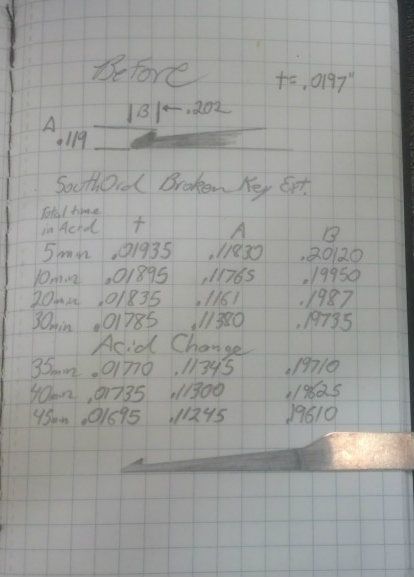 5 min, 5 min, 5 min. Didn’t want to go too fast. The pick was showing signs of irregular dissolution and I didn’t want the shape of the pick to get away from me. Better close up of the pick after 45 minutes in acid.  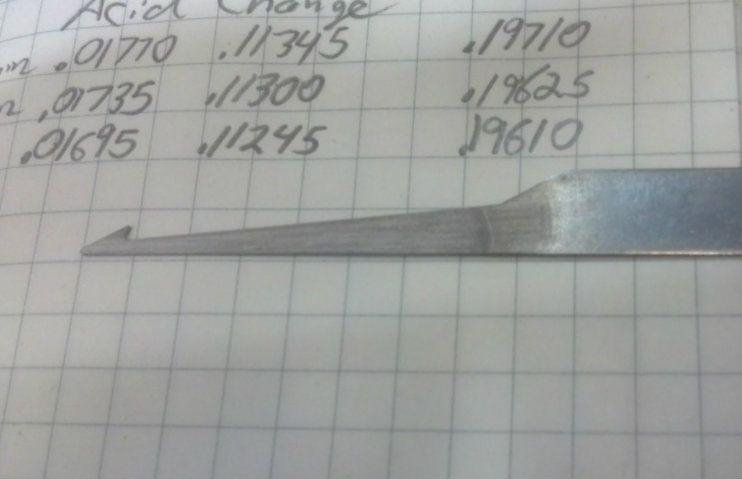 At this point I have reduced the pick thickness to .017”. I believe that I could have continued, I really wanted to see .015”, but the metal was starting to show channels and distinct irregularities and it was time to stop. The surface finish was very smooth to the touch in the way a matte painted surface is; smooth and soft, yet with an obvious texture. I took some 1000 grit sandpaper to it for 5 minutes of wet sanding. I timed this and limited it to only 5 minutes since the point of the reduction was to use acid and not wet sanding.  I hope the image is clear enough. The sanding put a very nice shine in the highest points of the flat. The dull parts of the picture are where the irregularities were developing and were below the depth of the wet sanding. I removed another .0005” while sanding so the depth of the crevices are slightly beyond that. Below is a chart showing a breakdown of the individual dips, their associated measurements and changes per.  Now I must point out that of course there is the possibility of human error when measuring, especially when measuring something this fine. I performed to the best of my abilities and I think the numbers are pretty consistent. In my next post I will evaluate the pick itself and mention some testing I want to do and some problems that may have developed during the process. I have not had time to test the pick yet and I will be explaining my thoughts later. Now I have to get ready for work. Thanks to anybody reading. ~Jesse
-
Anavaree
-
- Posts: 152
- Joined: 26 Jul 2011 8:53
- Location: Kentucky, USA
 by femurat » 16 May 2012 6:25 by femurat » 16 May 2012 6:25
Interesting and unusual approach! I've heard about electrolytic etching but have never seen a post about acid to scale down the pick. I enjoyed the reading. Cheers 
-

femurat
- Site Admin
-
- Posts: 3755
- Joined: 22 Sep 2008 9:06
- Location: Italy
 by raimundo » 16 May 2012 7:33 by raimundo » 16 May 2012 7:33
did ya wear rubber gloves and rubber apron, with an emergency shower and plenty of baking soda handy?
any accident that breaks that glass container, such as some metal tool accidentally striking it would be disaster.
you might also have to have very good ventilation with vent meaning wind.
stainless steel is an alloy, these are elemental metals mixed, I do not believe they form compounds, so the acid will then attack each element at a different speed. this can clear out some elements near the surface leaving a bit of porosity.
bronze (copper tin alloy) statues are sometimes acid washed and then gone over with hammers to compress the surface. especially when made for outdoor display.
what was the temperature of the acid, chemical reactions speed up with heat.
Wake up and smell the Kafka!!!
-
raimundo
-
- Posts: 7130
- Joined: 21 Apr 2004 9:02
- Location: Minnneapolis
 by Anavaree » 16 May 2012 15:51 by Anavaree » 16 May 2012 15:51
I had on latex gloves and safety glasses and that was it. It turns out that that beaker was only 30ml, not 50ml. It is also tempered glass and i have dropped those beakers before and they take a lot of force to break. But still, caution was used and there was an acid neutralization kit nearby, we have them all over the plant. And as you said, stainless is an alloy, I will get into the effects it had on the pick when I have a little more time. Raimundo, i read you post on my phone at work and I took a minute to make a little demonstration. The following is a vigorous reaction over a period of a few seconds. The previous pictures of the SouthOrd pic were taken over several minutes. 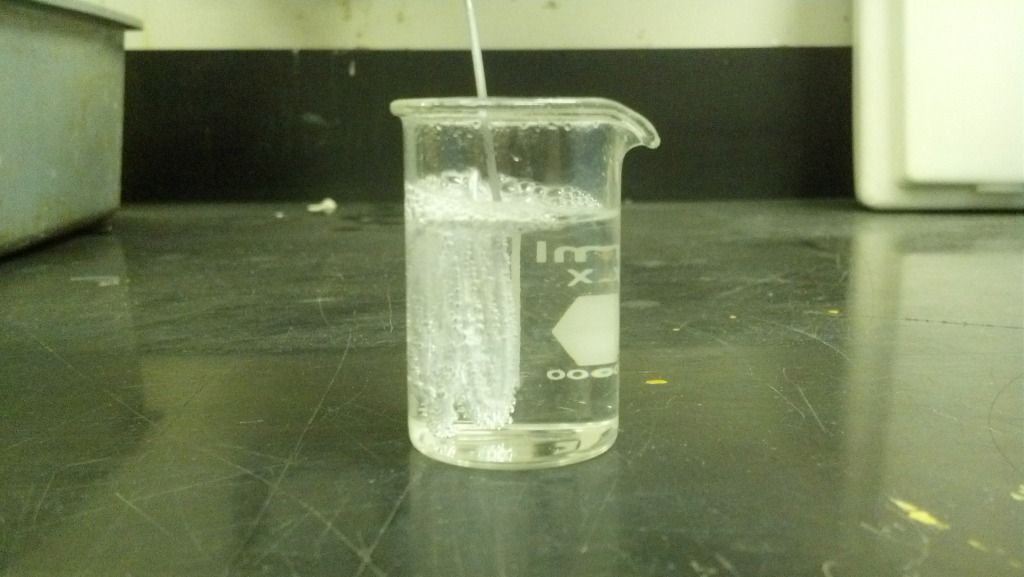 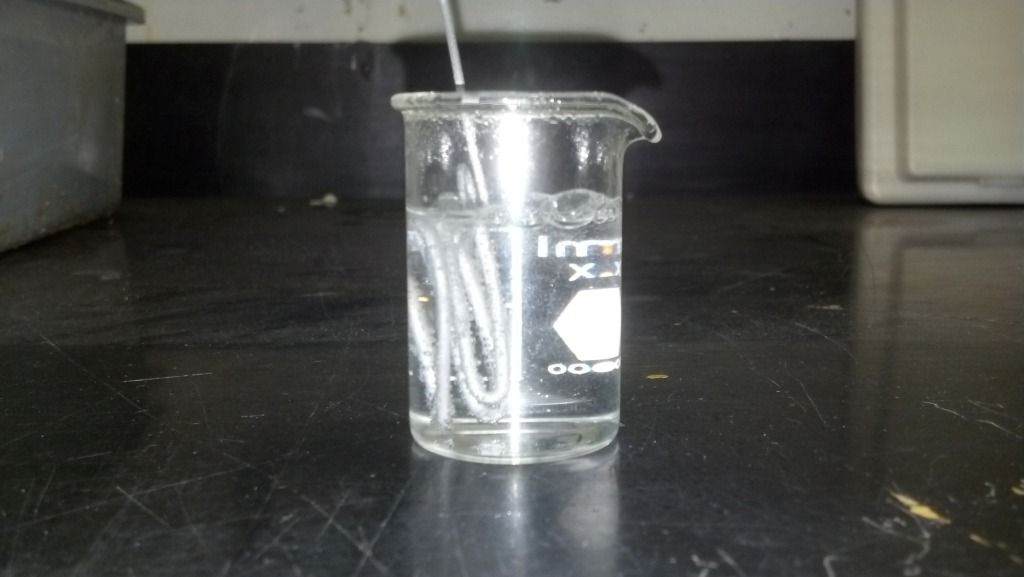 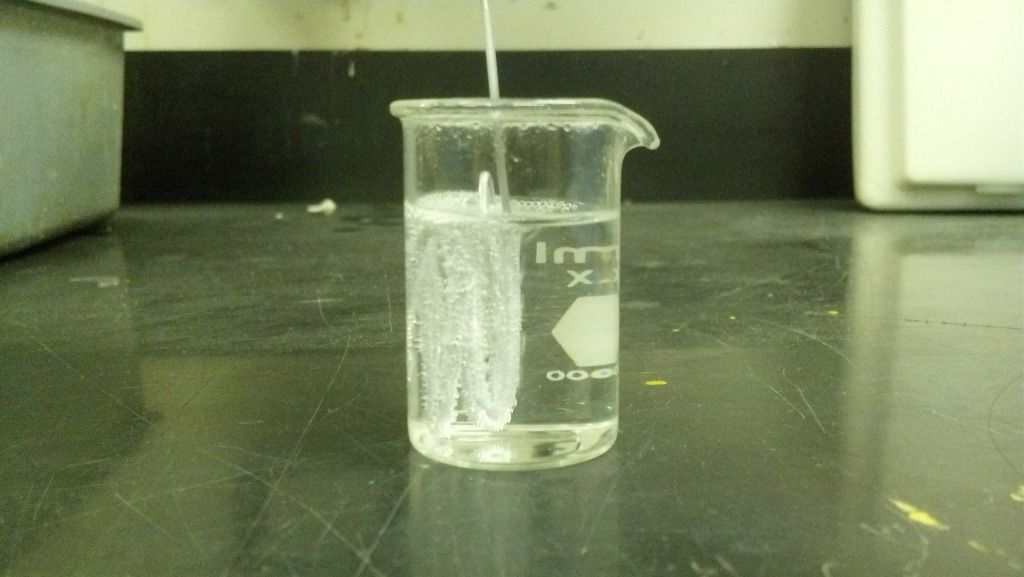   This produced quite a bit of gas and if i hadn't been in a gigantic under-roof production facility i would have wanted a fume hood, or something. I will hopefully post up my plans for testing later tonight. ~Jesse
-
Anavaree
-
- Posts: 152
- Joined: 26 Jul 2011 8:53
- Location: Kentucky, USA
 by Anavaree » 16 May 2012 15:54 by Anavaree » 16 May 2012 15:54
Why is there no edit button!
Forgot, temperature was 74-78 Fahrenheit.
-
Anavaree
-
- Posts: 152
- Joined: 26 Jul 2011 8:53
- Location: Kentucky, USA
 by Anavaree » 16 May 2012 19:59 by Anavaree » 16 May 2012 19:59
OK, the lawn has submitted to my will, it is now time to continue. As Raimundo was kind enough to point out, acids attack different metals at different speeds. HCL leeches iron out of whatever it’s eating. It is one of the properties that we count on at work but in this instance it may be causing harm. I intend to bend the pick in small increments until it fails or bends to 90 degrees. I will measure the amount of deflection it can handle and then perform the same tests to a new pick which has not been dipped. I also have a plan for a more scientific method of test. We perform tensile breaking tests on our wire to check the patenting, aka annealing, we perform. We use one of these. 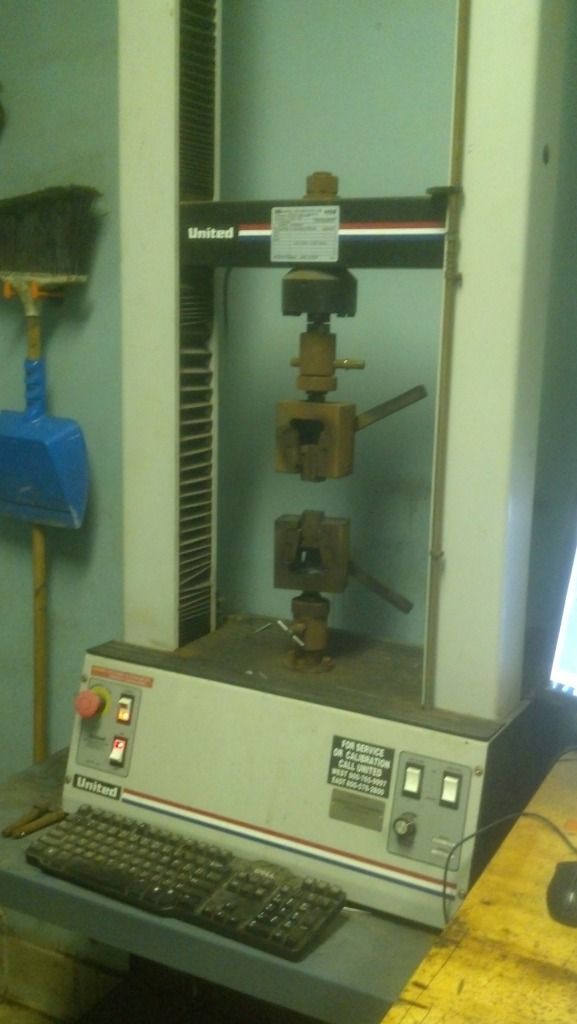 It pulls the wire apart with a maximum tension of 6700psi. I intend to use this to break 3 different version of the SouthOrd pick. I will break one as sold by SouthOrd as a baseline. I will break one that has undergone the exact same treatment as the test pick, except to the entire handle. I will break one that has been mechanically reduced by the same percentage as the original test pick. This is all assuming that my tester can break the entire handle of the pick in the first place. This test will demonstrate if the acid has damaged the strength of the steel alloy by removing certain elements. However, this is where you guys could help me. I have one more broken key extractor from an MXPS pick set from SO, I would need two more. I could use other, non-laminated handled picks, but I don’t really want to destroy any more of my picks. I might use them. If any of you out there has any stainless, non-laminated, MXPS lock picks and would be willing to donate them to SCIENCE! That would be appreciated. I only need 2 more. The operating end of the pick can be broken, I plan on using the entire handle for the test surface, not the slimmed down little picking end. I will try to break my base line pick at work tomorrow and let you know how it goes. If the machine won’t break it at all, I will abort and let you all know the results. Again, thanks for reading. I have really enjoyed this little experiment. Post up if you have a pick you wanna donate. By all means, bring on the questions. ~Jesse
-
Anavaree
-
- Posts: 152
- Joined: 26 Jul 2011 8:53
- Location: Kentucky, USA
 by Anavaree » 17 May 2012 20:11 by Anavaree » 17 May 2012 20:11
Slight delay of game.
I decided that i wanted to test the flexibility of the pick before i broke the handle and decided to build a little tester.
I will finish fabricating it at work tomorrow and flex the picks tomorrow night. The tensile test will have to wait for Monday.
~Jesse
-
Anavaree
-
- Posts: 152
- Joined: 26 Jul 2011 8:53
- Location: Kentucky, USA
 by Anavaree » 18 May 2012 21:12 by Anavaree » 18 May 2012 21:12
OK, so I got to it a little late. Honestly I am too tired to post all the results of what i tested tonight but i will put them up tomorrow. For now, here is the little test device I built. Its not very sophisticated but it works, mostly. 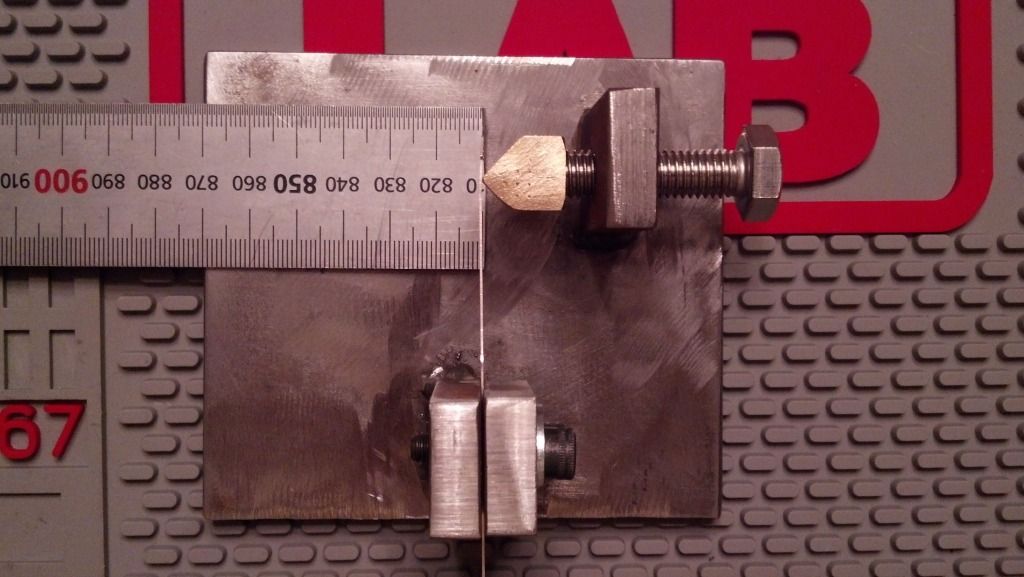  I have tons of pics of the testing I did. they have to be sorted and cropped properly. too tired. Must Sleep...
-
Anavaree
-
- Posts: 152
- Joined: 26 Jul 2011 8:53
- Location: Kentucky, USA
 by Anavaree » 20 May 2012 20:54 by Anavaree » 20 May 2012 20:54
OK, sorry to get back to it so late but I had a crazy weekend. I already showed you the little contraption that I built to do the testing. I will show the pictures in pairs, the normal pick first and then the acid dipped pick. However, I have just started going through the pictures and found that I am missing half of the pics that I wanted so I will do my best. I deflected both picks 10mm and allowed them to relax. Neither showed any permanent bend. Then 20mm deflection. Again neither showed any bend. 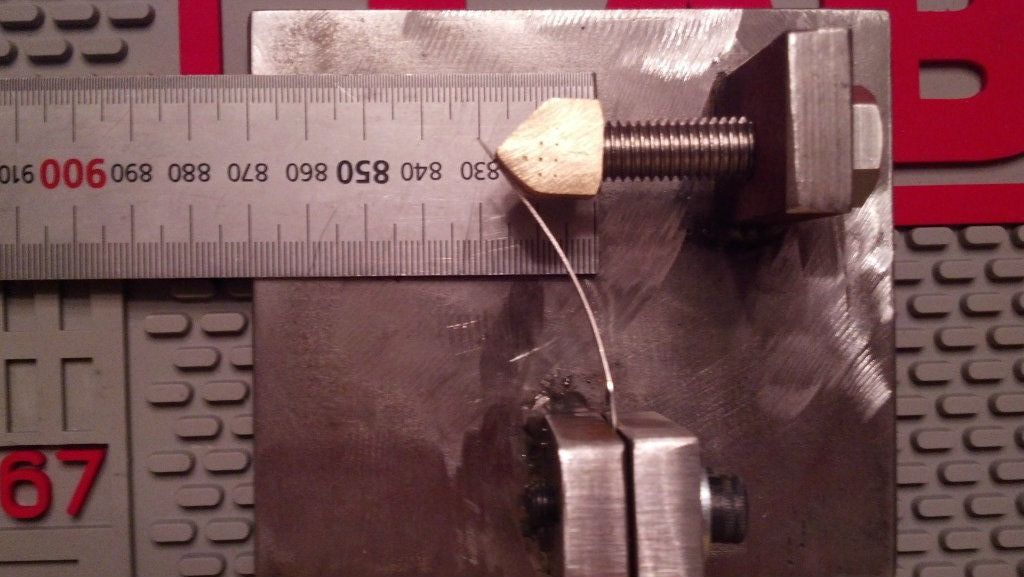  It turns out that my little jig didn’t engage the picks enough and I had to resort to bending them by hand. The later pics will reflect this. I moved on to 30mm for both. The normal pick returned to normal and the acid dipped pick stayed bent about 1mm. still not a significant change. 40mm manual deflection. I can't get this pic to orient properly.  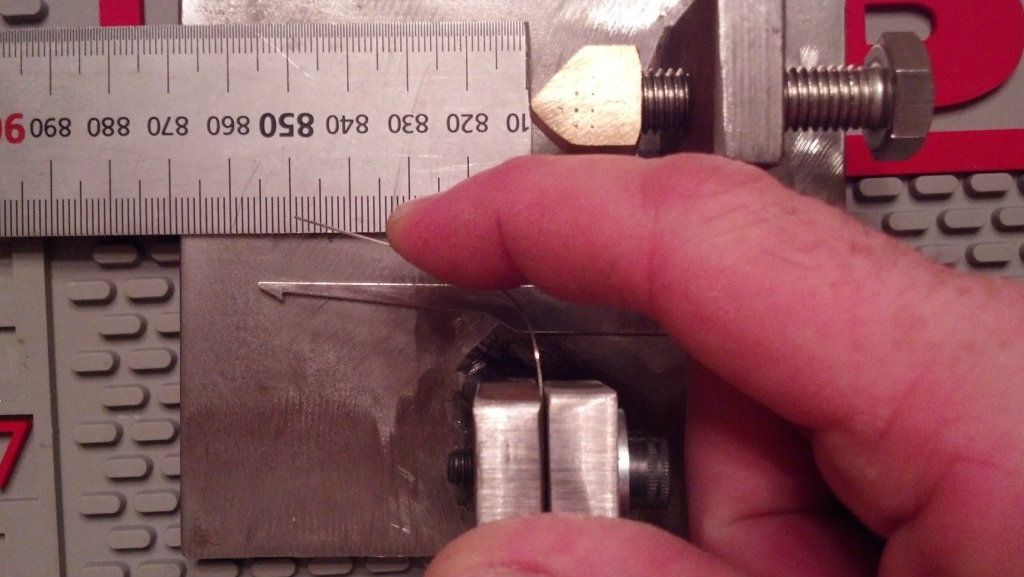 The results once relaxed. Normal then acid dipped. 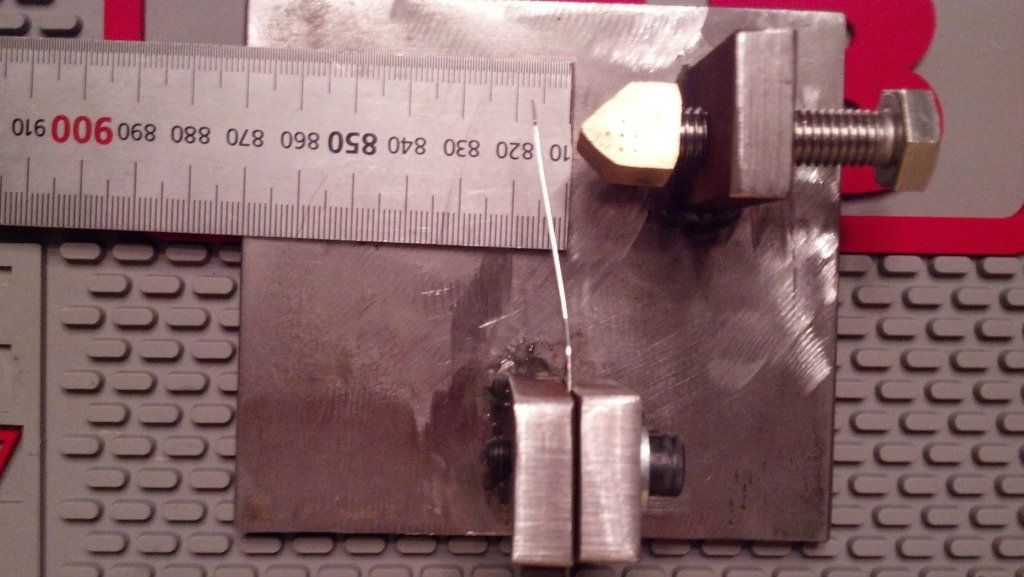 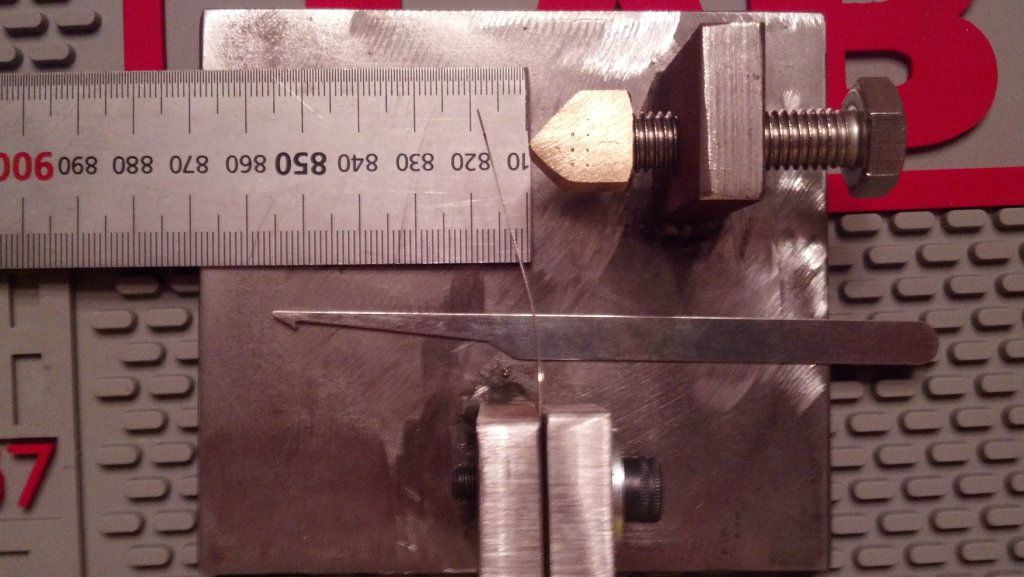 I really wasn’t getting any sort of important results so I really bent them over. 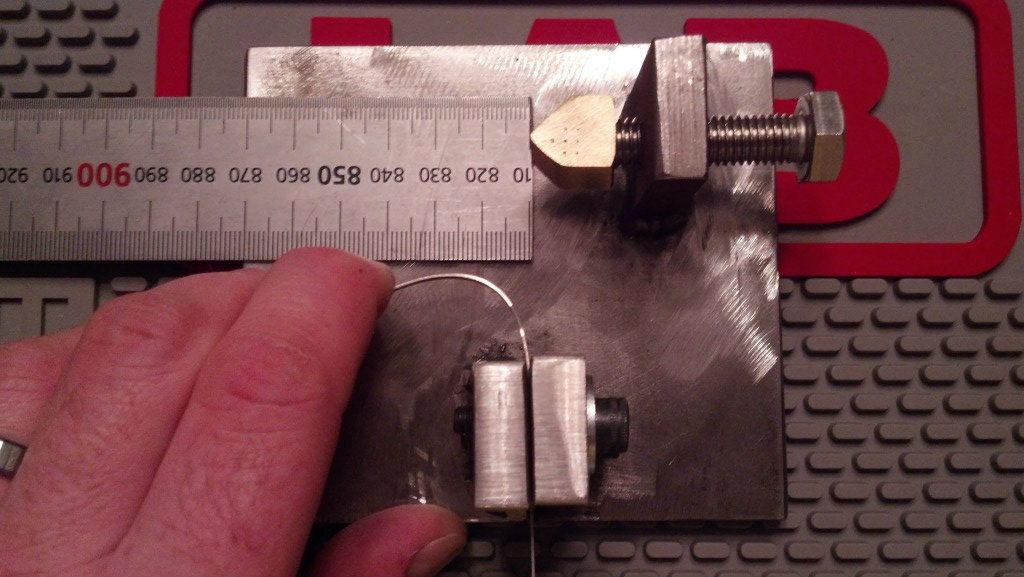 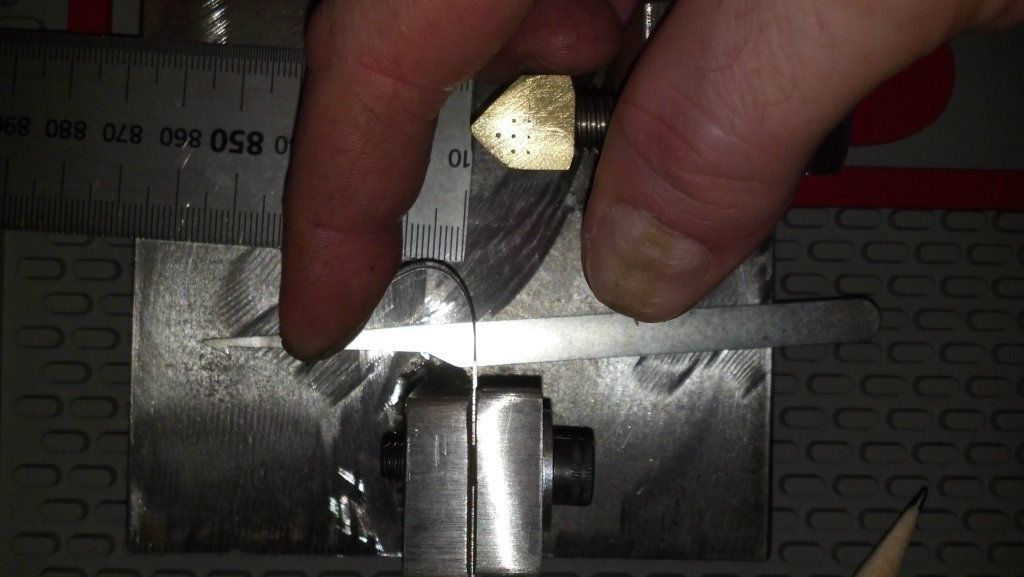 At this point I got both picks to bend and stay bent pretty badly. My final deflection was similiar for both but the acid dipped pick stayed bent much more than the normal pick. The acid dipped pick is in the back. 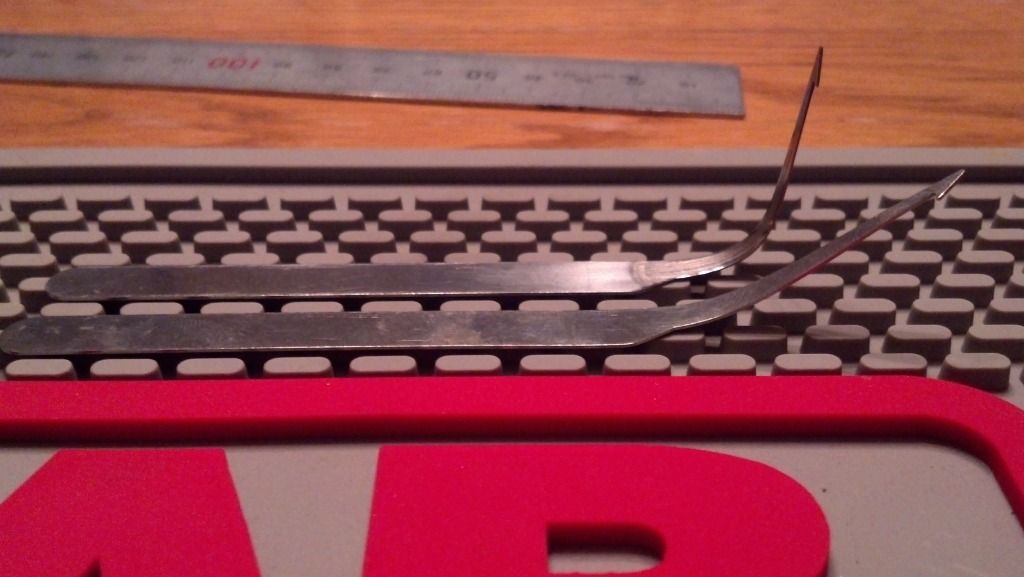 In this picture you can see the grain of the pick starting to come out.  Both picks were able to survive a great deal of abuse and the only real question is; did the dipped pick stay bent more simply due to the fact that the metal was thinner, or, did the acid treatment change the properties of the steel? Once I have mechanically reduced another pick to the same thickness as the acid reduced pick and bent it I will find out. I will point out that the normal pick was much harder to deflect by hand, again is this from being a thicker metal that the dipped or was there a change in the chemistry of the steel? Have to move onto the next pick to find out. Monday I will tensile break the normal pick and I will try to acid dip the whole pick handle and break that on as well but I never know how busy I will be at work. I hope this made sense to everybody, I think my pictures were lacking a little and my tester didn’t work out as well as I was hoping, but all in all I think I demonstrated the flexibility of the picks pretty well. Please ask for clarification if any of you care. Thanks ~Jesse
-
Anavaree
-
- Posts: 152
- Joined: 26 Jul 2011 8:53
- Location: Kentucky, USA
Return to Lock Picks
Who is online
Users browsing this forum: No registered users and 4 guests
|

































